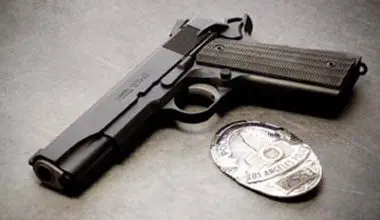IT’S not uncommon for people of a certain era not to have appreciated that era when they were living in it. As an example, who would ever have envisioned that police service revolvers would be relegated to the dustbins of history or that the straight stick hickory baton would one day grace a display case in the police museum?
Some websites discuss in great detail old police equipment. Collectors of such items place a premium on equipment that is no longer manufactured and hard to find. Of course those of us who used this equipment on the job never saw this coming and so much of this antiquated gear was given away or simply lost.
Try to find a clamshell holster that isn’t already spoken for, or the nickeled, spring-steel .38 Special speed strip commonly issued to recruits during my LAPD Academy days in 1976.
For that matter, try to locate a “Brucie Brown” duty rig with a breakfront holster. (This deplorable system used copious amounts of Velcro between the outer duty belt and inner underbelt and left sores on your sides after about a week of street wear.)
The breakfront holster was neither fast nor effective, and returning a fourinch revolver into it without pulling down one’s uniform trousers in public was always a bit of a challenge.
A police Gamewell call box key made of solid brass was issued to all recruits back then for the blue castiron Los Angeles Gamewell boxes that were affixed to posts and telephone poles throughout the city. It was a simple, direct police-line telephone and nothing more. It dated back to the 1800s. Older models depicted a raised relief fist, with two lightning bolts contained within its grasp. Ostensibly, this meant it was both effective and “lightning- fast” to use.
I never used it once during my entire probationary time in Wilshire Division. Then one fine day, the city announced that the Gamewell system was to be defunct, kaput, no more! City planners put aside funds for their removal.
I distinctly remember the day the Gamewells were scheduled to be removed. The old timers came to roll call, left roll call, and immediately transferred bolt cutters, wrenches, and such devices from their personal vehicles to the black and whites. It was then a mad scramble across the city’s streets for as many Gamewells as could be fitted into the black and whites’ trunks and back seats.
Being a fresh-faced novice, I had no idea what I was witnessing. To make a long story short, every Gamewell throughout the city was gone within 24 hours! No city funds were required for their removal—not one dime.
Today a righteous Gamewell costs hundreds of dollars … if you can even find one. Replicas are made, but they’re not the same as a “real” one, which will have bullet holes, strikes, and ding marks from decades of Los Angeles City abuse. My partner bagged about six of these beauties. I have my original issued Gamewell key (nicked and worn, but never used) in my shadow box, but I do not have a “real” Gamewell.
The same can be said for the Mickey Mouse ears on the black and whites. These had the shop number of the car in gold and black lettering on their outboard side. These too command a small fortune and, as with the Gamewell, the old timers saw to it that not one of these ever made it to the boneyard. The bell-shaped, chromedcenter mounted siren? Same fate. If an old-time Los Angeles Police cop has a bar, it is most probably festooned with a Gamewell call box, two Mickey Mouse ears, and a genuine police siren so he can reminisce about the good old days while downing an ice-cold beer.
To this day, I distinctly remember standing on the roof of Wilshire Station gazing toward the Pacific Ocean before my first-ever roll call as a rookie Los Angeles Police Officer. A Pacific breeze rolled in under an amber-hued setting sun on Venice Boulevard while sirens wailed in the distance.
It was one hell of a ride until 2006, but I did not know it then. It was a simpler era, with less equipment and less paperwork, and a greater emphasis was placed on one’s wits and common sense to be a solid officer. Training Officers had decades under their belt, not just two years. Watch Commanders had white hair and had been there.
Years from now, I suppose Blackberrys, Tasers, and less-lethal munitions will be displayed in police museums. Plasma-ray diffusers will be all the rage then. GPS-embedded chips will recount, record, and analyze every second and action of your time on the streets. Drones will be pre-deployed to ensure your safety, while a heads-up display on your police issued virtualreality eyeglasses will scroll through a list of 1,000 options available to you on the upcoming call. But it won’t be the same. Not by a long shot.



